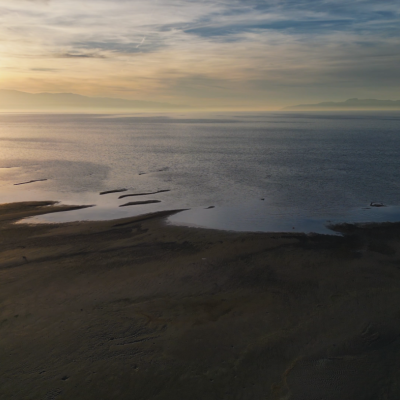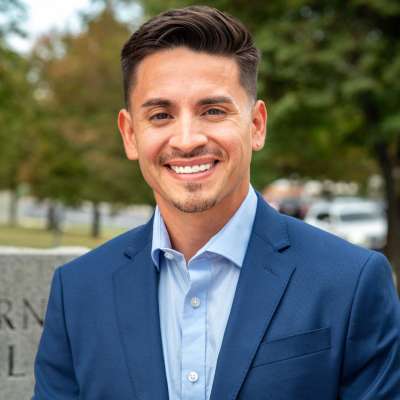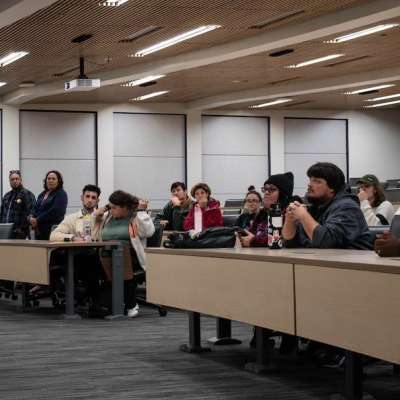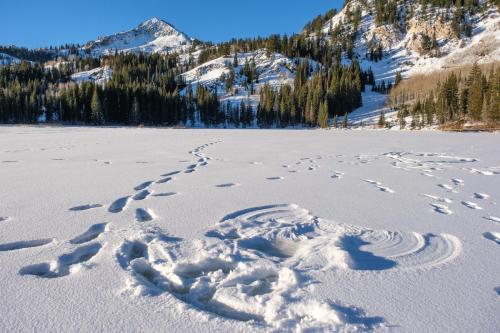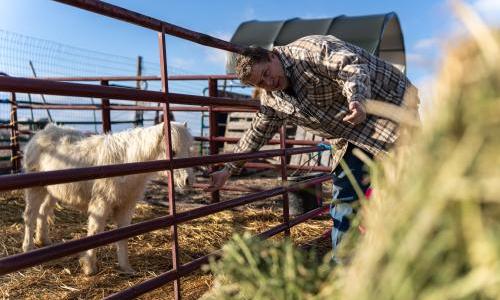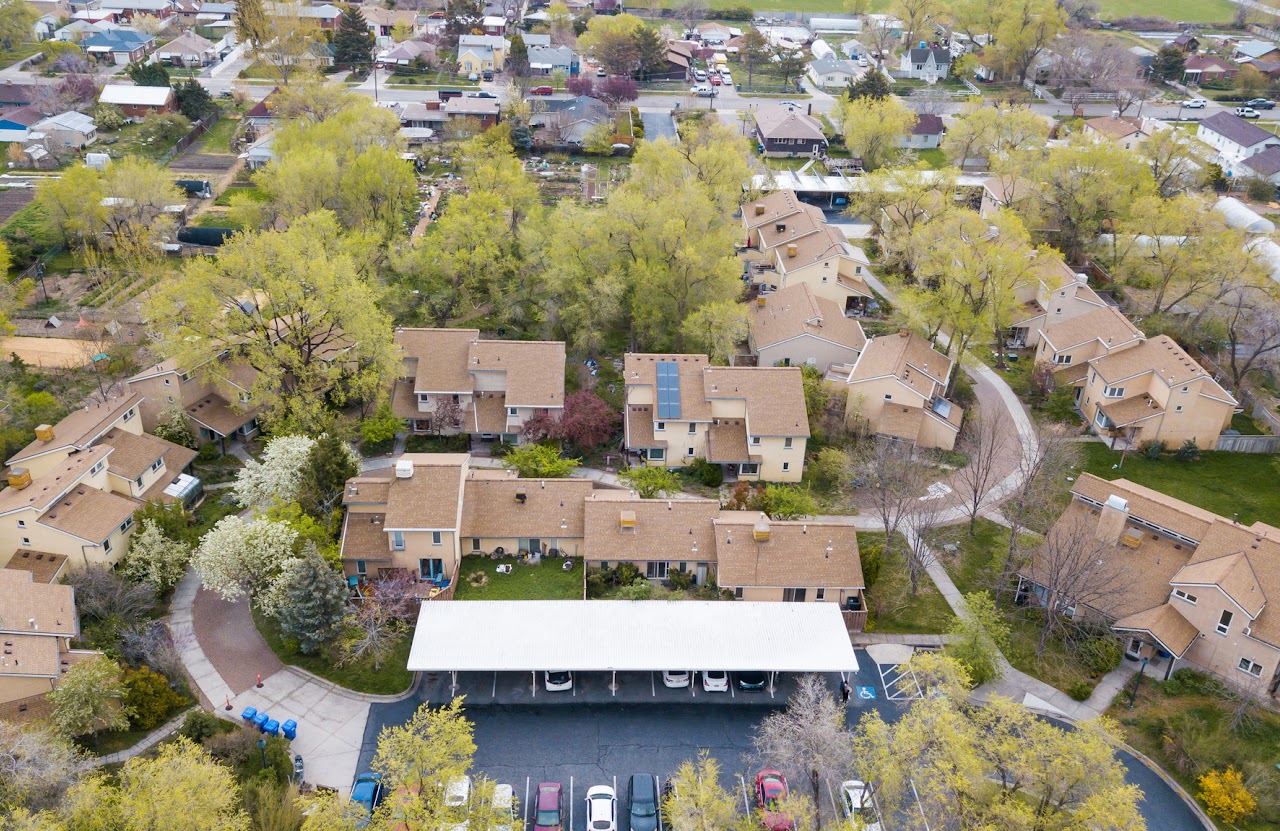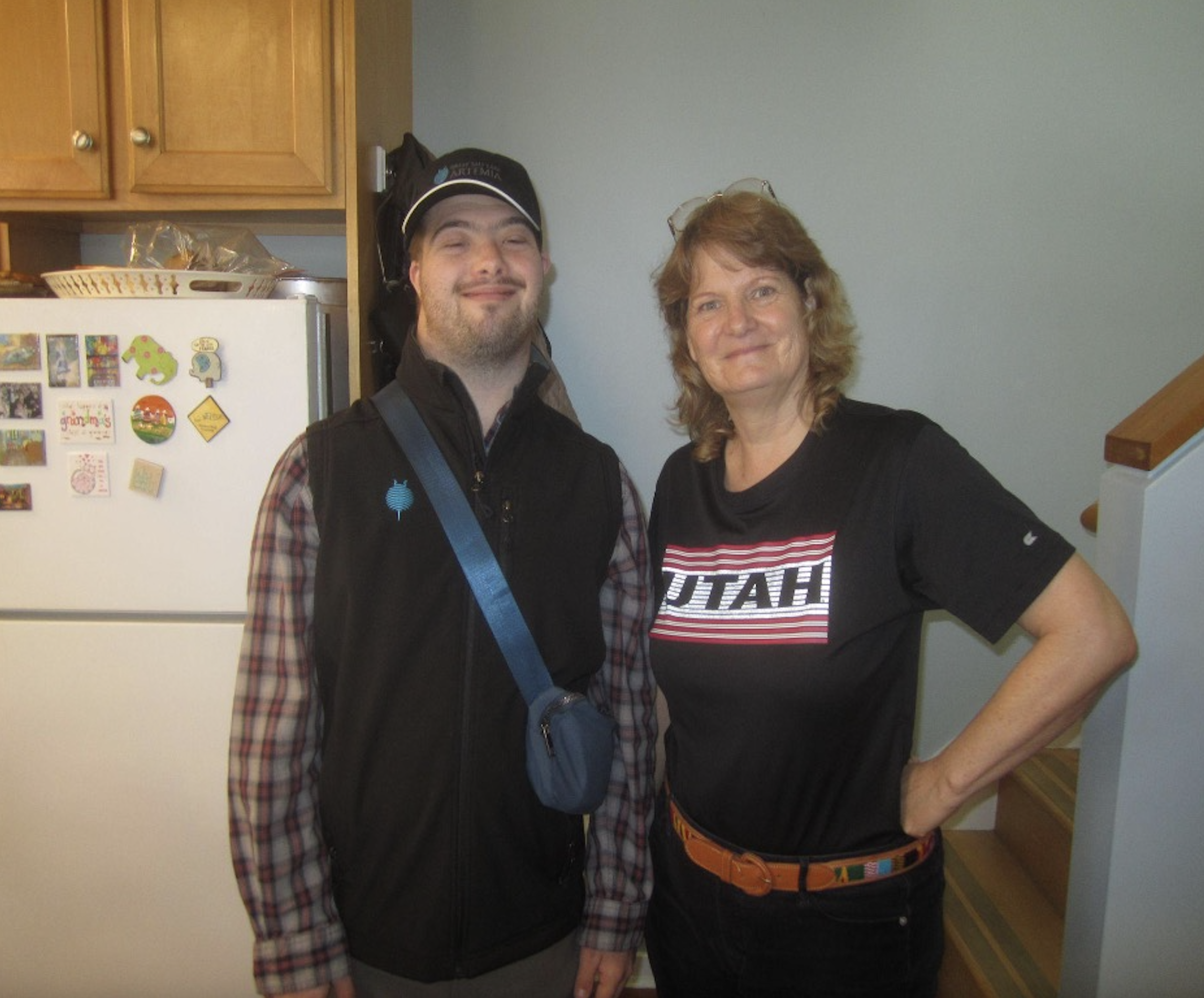Chris Eddington lives in a peaceful, modest bungalow at the end of a small dirt road in Tooele County. Three horses roam his half-acre property less than a mile from Great Salt Lake. Wearing a pair of cowboy boots, a plaid jacket and blue Levi jeans, Eddington said he’s frustrated with a recently approved inland port that’s on the other side of his horse stable.
“If they’re gonna put manufacturing in, I got to worry about pollution,” he said. “I got to worry about groundwater pollution because I’m on a well … all of this stuff has to do with my way of life, my property value. Who's gonna want to buy a house with a factory behind it?”
 Tooele County resident Chris Eddington, whose backyard borders the recently approved Tooele Valley inland port project, poses for a photo in his house on February 27, 2024. (Photo credit: Xiangyao “Axe” Tang)
Tooele County resident Chris Eddington, whose backyard borders the recently approved Tooele Valley inland port project, poses for a photo in his house on February 27, 2024. (Photo credit: Xiangyao “Axe” Tang)
Eddington, like many in Tooele County, said he feels county officials and developers communicated poorly over the last year and ignored concerns during the approval process for the development of two inland port projects in the county.
Teri Durfee, a lifetime Tooele County resident, said she has opposed the development since she saw the first iteration of one of the port developments plans four years ago.
“The thing that upsets me is that there hasn’t seemed to be a concern for what the people most affected in the community care about,” she said.
 Tooele County resident Teri Durfee, who lives near the recently approved Tooele Valley inland port project, posing for a photo on his property on February 27, 2024. (Photo credit: Xiangyao “Axe” Tang)
Tooele County resident Teri Durfee, who lives near the recently approved Tooele Valley inland port project, posing for a photo on his property on February 27, 2024. (Photo credit: Xiangyao “Axe” Tang)
Residents, like Durfee, say they worry about the possibility of the developments worsening Tooele’s already bad water issues, damaging wetlands and increasing noise and air pollution and traffic.
Ben Hart, the director of Utah Inland Port Authority, says that community input will be an important part of the port’s direction.
“Everything that we’re doing as a whole is according to local ordinance and anything that will require public transparency, we’ll allow the public to be involved,” said Hart. “And so I think that the ability to still help shape a good development that is very friendly to the neighborhood is not only possible but very vital.”
‘A losing battle’
At a December meeting, the Utah Inland Port Authority board unanimously approved both the Tooele Valley Port Project – to be located about half an hour from the county seat and near Eddington’s house – and the Twenty Wells Port Project in northern Tooele County.
Nearly 30 people packed into the meeting room to share their opposition to the project. Among them was Durfee, who lives a few miles from Eddington, and other residents who expressed frustration the projects seem “all but decided” and have been since at least October 2023.
“My big concerns are the big growth we have here, the traffic and … [the] wetlands, that scares me because we’re losing [Great Salt] Lake,” Durfee told the board during the meeting, held on an early Tuesday morning.
Meeting leaders allowed four public comments, which added to the frustrations. Stop the Polluting Port, an advocacy group, held a conference directly afterward with residents to share details about their opposition to the project.
“It doesn't matter what we say, what we want – they're going to do whatever the heck they want to do,” said Mike Croley, a resident who has lived near the proposed Tooele Valley port area for 22 years. "I'll fight it until the end, but I think it's a losing battle."
Looking for positives
Developers of both projects and city and county officials have argued the ports will create quality jobs in the community, including working freight and stock for the Twenty Wells project. For the Tooele Valley Port Project, clean air manufacturing and data center technician jobs are expected based on companies who have approached them, said Charles Akerlow, managing director for Zenith Development and the Tooele Valley project lead.
“One company is a manufacturer of electric vehicles. Another would build small 500-square-foot homes for use in low-income housing sites,” Akerlow said. “We have had several who will provide i-cloud services through data storage centers which employ highly skilled technical people.”
They haven’t yet been approached by companies that are trans-loading facilities, but he said the site is “well-suited” for that.
Some residents, however, said that's not much of a positive.
“They're not jobs that you could sustain a family and live off of,” said Kyle Mathews, who lives near the Twenty Wells project.
The median pay for freight and stock jobs in Utah is $35,400 a year, according to the state’s Department of Workforce Services. The median sales price of a home in Tooele County as of February 2024 is nearly $463,000, according to the Tooele County Association of Realtors.
 Tooele County resident Kyle Mathews, who lives near the recently approved Twenty Wells inland port project, posing for a photo on his property on February 27, 2024. (Photo credit: Xiangyao “Axe” Tang)
Tooele County resident Kyle Mathews, who lives near the recently approved Twenty Wells inland port project, posing for a photo on his property on February 27, 2024. (Photo credit: Xiangyao “Axe” Tang)
Akerlow said it’s too early to say how many jobs the Tooele Valley development will create, but estimated the “current property size could generate as many as 1,500 jobs.”
Mathews, who opposes both of the developments, said he worries the projects will lead to industrial sprawl across the area. People, he said, don’t want to live in a “concrete jungle of warehouses.”
“Who wants that in their backyard?” Mathews said. “We're not an industrial community. We're not even really a suburb community – we’re a rural community.”
Bryson Anderson, one of Eddington’s neighbors, said people settle in the area to get away from noise in the city, railroads and traffic.
“[This project] kind of defeats the purpose of coming out here,” Anderson said. “It’s a neighborhood street, and it’s not going to be a neighborhood street anymore.”
A fight since 2018
The Utah Inland Port Authority has argued their inland port project sites, planned for across the state, will help Utah’s environment and economy because they support more rail infrastructure. But, the project has faced backlash since it was first created in 2018, which led to protests shuttering board meetings and ending in arrests.
Opponents of the ports have argued the projects will have a negative impact beyond neighborhood changes, including further threatening air and water quality across the Wasatch Front.
In a 2023 report, Stop the Polluting Port and Utah Physicians for a Healthy Environment said the ports are the biggest threat to Great Salt Lake’s wetlands, which are important to preserve in order to save the shrinking lake.
Deeda Seed, who volunteers with Stop the Polluting Port, said the coalition is already looking into taking legal action related to the Clean Air Act, the Clean Water Act and the Endangered Species Act as part of the actions around Tooele’s port projects.
“There might be litigation hooks for us, and we're looking for those because that is one way that is one way to stop the harm,” Seed said.
A Human Impact
Tooele County, in general, has more unique water issues since they are not a part of a water district and their wells, which much of Tooele Valley homes rely on, have already started to run dry, according to the 2023 report.
Jonny Vasic, executive director of Utah Physicians for a Healthy Environment, said his concerns about the Utah inland port projects stem from the small number of environmental assessments, human health risk assessments and west-side assessments.
 An aerial photo of the recently approved Tooele Valley inland port project, which many local residents oppose, on March 15, 2024. (Photo credit: Xiangyao “Axe” Tang)
An aerial photo of the recently approved Tooele Valley inland port project, which many local residents oppose, on March 15, 2024. (Photo credit: Xiangyao “Axe” Tang)
Several environmental assessments, including a wetlands mitigation study, have been completed for the Tooele Valley project, Akerlow said.
The 2023 report details that all Utah inland port developments could increase air pollution, noise and light pollution, and the use of pesticides, which could negatively impact nearby wetlands, the ecosystem and people who live close by.
The report noted that noise pollution is the second largest environmental cause of human health disorders after air pollution.
Artificial light exposure at night, which these projects will contribute to, can “negatively affect human health, increasing risks for heart disease, obesity, depression, sleep disorders, diabetes, breast cancer, childbirth complications and more,” according to Dark Sky.
Vasic said, regardless of the specifics of how bad the environmental impacts are, one thing is for sure—“there is no such thing as a clean port.”
“Any port that's ever come in increases diesel pollution by a great deal because more trucks are coming and going, increased noise pollution, … increased light pollution,” Vasic said. “All of those things have health risks associated with them.”
Building begins
The Tooele Valley port project, located near the I-80 Burmester exit and one-fourth mile south of Great Salt Lake, sits on about 250 acres. It is, however, likely to increase in size, possibly as much as double, said Akerlow.
Akerlow said the port will include “light manufacturing” warehousing but didn’t share more details. Many residents said they are frustrated it’s still unclear what exactly these warehouses will include.
“How can you guys get funding, get approval for something you haven’t fully figured out?” Eddington said.
Utility work is in the early stages, including building a new road, setting up gas and electricity and drilling a new well. Akerlow said utility work should be finished by the end of 2024.
Although the project area includes some wetlands, Akerlow said they’re not planning to build anything on them. But Seed, who is also the public lands senior campaigner for the Center for Biological Diversity, said there’s still “obvious harm to the ecosystem” if you build near wetlands.
“You're disrupting everything, paving it over with concrete, depleting water resources and bringing polluting trucks in and out,” she said.
According to the Utah Division of Wildlife Resources, the wetlands surrounding Great Salt Lake are “of international importance,” especially since some estimate over 90% of Utah’s original wetlands have been destroyed.
“Wetlands play an incredibly important role and keeping all of us healthy,” said Seed. “They filter water, they help keep our air clean, they suppress dust.”
The Twenty Wells project covers about 500 acres and builds upon the Lakeview Business Park, a warehouse complex the Romney Group plans to develop. Josh Romney, son of U.S. Sen. Mitt Romney, leads the project as the group’s president.
The land doesn’t have any wetlands, according to an environmental assessment conducted by the Utah Inland Port Authority. But an abandoned rail spur that Savage Tooele Railroad plans to rebuild to connect with the Twenty Wells project goes directly through Great Salt Lake wetlands.
As residents and advocacy groups continue to fight inland port development, Seed said she can’t help but feel Tooele residents are “getting rolled over.”
“These poor people who I've gotten to know over the years are going to be the victims of a huge environmental injustice,” she said.
Correction (April 11, 2024) • This story was updated to correct the year the Utah Inland Port Authority was created and added comment from Ben Hart, the director of Utah Inland Port Authority.
Andrew Christiansen, a senior at the University of Utah, wrote this story as part of a College of Humanities journalism course in partnership with the Great Salt Lake Collaborative and Amplify Utah. The collaborative is a solutions journalism initiative that partners news, education and media organizations to help inform people about the plight of the Great Salt Lake – and what can be done to make a difference before it is too late. Read all of our stories at greatsaltlakenews.org.







